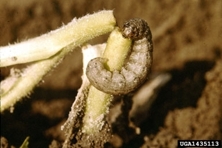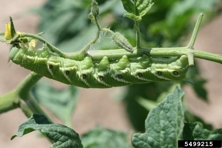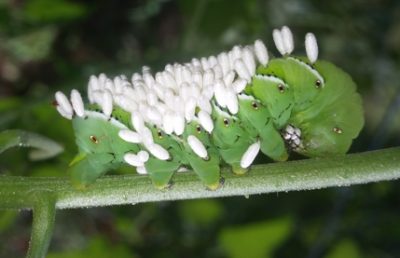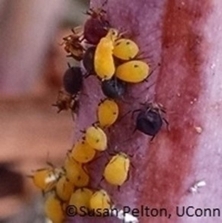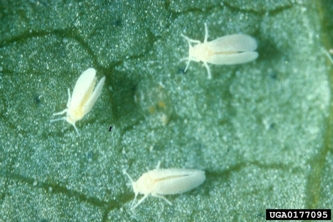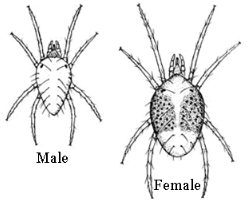Tomatoes
Site and Soil
Choose a planting site which will get direct sunlight most of the day. Open airy sites allow good air flow which helps reduce foliage diseases and cold air injury.
Tomatoes can be grown in most moderately to highly fertile soil types. Sandy loam soils which drain well and warm up quickly favor early crops but may require more watering in mid- to late season than heavier soils. Soil pH should be maintained in the 6.0 to 7.0 range by adding limestone if indicated by soil tests.
Tomatoes grow well in soils rich in organic matter. Well-rotted manure or thoroughly decomposed compost can be worked into the soil before planting time, at rates up to two bushels of manure or four bushels of compost per 100 square feet.
Mineral fertilizers like 5-10-10 or 10-10-10 can b1 broadcast and mixed into the soil just prior to planting, at rates indicated by soil tests. Do not exceed 4 pounds of 5-10-10 or 1 and 1/2 pounds of 10-10-10 fertilizer, or equivalent amounts of another fertilizer, per 100 square feet.
Varieties
This warm-season crop is available in a wide variety of plant and fruit characteristics including earliness, plant form, disease resistance, and fruit color and shape. Varieties designated determinate often have a compact bushy plant form with limited growth after fruit initiation, while indeterminate varieties continue to grow and set fruit throughout the season.
Varieties designated Fl, F2, V, etc. are resistant to various diseases. Resistance to fusarium wilts (F1,F2) and verticillium wilt (V) is especially valuable. The average number of days from time of transplanting to maturity is also frequently given for each variety.
The following varieties or hybrids are among those found suitable for Connecticut gardens:
| Early Season | Spring Set (VF), Early Girl, Pilgrim (VF2),4th of July, Early Cascade |
| Midseason | Jet Star (VF), Ultra Boy (VFN), Celebrity (V,F,M), Mountain Magic (AL) Mountain Pride (F,V) Mountain Supreme (AL) |
| Late-season | Supersonic (VF), Better Boy (VF), Ramapo (VP), Super Beefsteak (VFN), Burpee's Supersteak Hybrid (VFN), Brandywine |
| Orange | Burpee's Jubilee, Orange Queen, Orange Sweet, Tangerine, Harless Creek Gold |
| Yellow | Golden Delight, Yellow Stuffer, Yellow Brandywine, |
| Plum | Black Plum, Casa del Sol, Orange Banana, Mama Leone |
| Cherry | Small Fry (VF), Tiny Tim, Pixie (VF), Sweet 100, Cherry Grande (VFI), Sun Gold, SunSugar, Cherry Brandywine, Snow White |
Planting
All danger of frost must be over before tomatoes can be safely placed outdoors. In fact, chill injury may occur at temperatures below 50ºF for many varieties. The average last frost date in Connecticut is mid- to late May, but varies considerably with season, location and site.
Seedlings should be started indoors six to eight weeks prior to the transplanting date. Well-developed seedlings (6 to 8 inches tall) may be transplanted into the garden when soil temperatures reach 65ºF and daytime air temperatures average 55º to 60ºF.
When planting out in the garden, space seedlings to give five to six square feet per plant. For example, two feet apart in rows three feet wide if tomato cages are to be used. Plants which will be staked and pruned can be planted closer, while those to be grown flat on the ground require more room. Set transplants two to four inches deep. Excessively elongated stems can be partially buried horizontally at this depth. Liquid fertilizer starter solutions reduce transplant stress.
Care
Weeds may be controlled by shallow cultivation, by an black plastic mulch, or by a thick organic mulch such as straw. Mulches serve additional functions by conserving water and reducing plant and fruit contact with the soil. Organic mulches keep soils cool and should not be applied before July.
Supporting vines on stakes or twine trellises and pruning, allows closer spacing and improves air circulation, thereby reducing vine diseases, and makes cultivation easier. Such pruning may reduce the total yield somewhat but gives larger fruit. With these methods, the supports can be five to eight feet high. The plants can be pruned to one or two main stems by saving a strong lower lateral (side) bud to make the second stem and pinching out the other lateral buds as the stems grow. Stems should be tied to the supports.
Wire tomato cages may be used as an alternative to staking or flat ground culture. Indeterminate varieties can fill a cage 18 to 24 inches in diameter and five feet high. Caged plants need not be pruned. For early plantings, transparent plastic can be wrapped around the cages to protect against cold winds. Be sure to open the top on sunny days. High temperatures within a closed cage can kill the plant.
Tomatoes need about one inch of water per week. If rain is insufficient, soak thoroughly at weekly intervals. Irregular watering may cause blossom end rot or fruit splitting. Light sandy soils may require mid-season fertilization, especially after long periods of rain. One or two side dressings of one to two pounds of 5-10-10 or half as much of 10-10-10 (or equivalent amounts of other fertilizers) per 100 square feet can be applied after the first fruit clusters are formed. Apply three to four inches away from the stems and water the fertilizer into the soil.
Common Tomato Insect Pests
| Flea beetles |
Make large numbers of small feeding holes in the leaves. This may seriously weaken transplants but is less damaging to larger plants.Lightweight floating row covers make good insect barriers which can be removed after plants reach the six leaf stage. Diatomaceous earth can be sprinkled on the ground around affected plants to control the flea beetle larvae that are in the soil. |
| Cutworms
|
Can be a serious problem for transplants. Barriers several inches high can be made by wrapping paper, aluminum foil, and thin cardboard or similar materials around the base of transplant stems. |
| Tomato hornworm caterpillars
|
May consume large quantities of foliage and green fruit. Hand picking and destruction of the caterpillars, and tillage after harvest to destroy soil-borne pupae are effective controls. Caterpillars bearing 1/8 inch white cocoons of parasitic wasps attached to their skins should not be killed. |
| Aphids
|
Small soft-bodied, often greenish, insects which feed by sucking on the undersides of leaves and the tender terminal growth. Their feeding can cause curling of the foliage. They are carriers of several virus diseases. |
| Whiteflies
|
Small white insects which feed on the undersides of leaves. The juvenile stage resembles a small scale-like insect. They are sucking insects which excrete a sugary substance called honeydew which supports a blackish fungus called sooty mold. When disturbed, the adults fly about for a few moments. Yellow sticky traps can be used to control and monitor the populations. |
| Spider mites and rust mites
|
Cause a yellowing to russeting of the foliage while rust mites also attack the fruit. The spider mite is 1/50 of an inch while the rust mite is 1/150 of an inch long making them difficult to see. |
Numerous lesser pests or conditions may cause tomato problems occasionally.
Samples or images of the damaged plants and the suspected pest(s) can be brought to your regional Cooperative Extension Center or sent, brought or emailed to the UConn Home and Garden Education Center for identification and control information.
Common Tomato Diseases
Septoria leaf spot, early blight and late blight are common foliage diseases caused by fungi. Septoria leaf spot does not affect the fruit but shows up first on lower leaves as numerous small spots with black specks in the center on the leaves. Early blight (Alternaria solani) leaf spots have tan centers with concentric rings and yellow halos, usually one or two spots per leaf and dark, sunken areas on the stem end of fruits. Late blight (Phytophthora infestans) begins as pale green areas near the edges and tips of leaves which then turn brown and purple-black. The fruit will have dark, leathery areas on the tops and sides.
Fusarium wilt and Verticillium wilt are common root diseases caused by fungi. Because of soil-borne spores, an important control of these diseases is rotation of plantings of tomatoes and their close relatives (potato, eggplant, peppers) so they are not grown in a site more often than once in three years. Removal and destruction of infected crop residues and cultural methods that promote rapid drying of wet foliage are also important for control of foliage diseases.
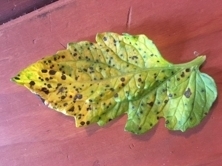
Septoria leaf spot

Early blight
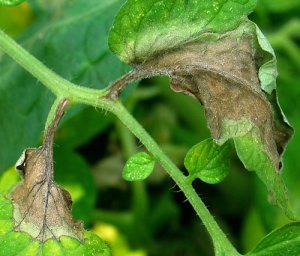
Late blight
Varieties resistant to Alternaria, Fusarium and Verticillium wilts are readily available. Please see Vegetable Garden Basics for a listing of resistant varieties. Foliage diseases spread rapidly in wet weather. Preventative and treatment applications of fungicide sprays or dusts may be necessary. Use only products which clearly state on their labels that they can be used on tomatoes. Follow label directions carefully.
Please contact the UConn Home and Garden Education Center for control suggestions.
Despite good cultural practices, pests and diseases at times may appear. Chemical control should be used only after all other methods have failed.
Common Physiological Problems of Tomato
Failure to set flowers could be due to insufficient sunlight and/or excess nitrogen (overfertilization). Blossom drop may be caused by temperatures below 55ºF, or above 85ºF, or by excessive nitrogen fertilizer.
Blossom end rot of fruits may be caused by inadequate or uneven water supply and excessive nitrogen and certain other conditions which interfere with calcium nutrition in the fruit. Internal hardening, discoloration, or tissue collapse may be present even if there are no outward signs (image on right). Maintain a consistent water supply (1-2" per week) and mulch around plant bases to help conserve moisture during hot, dry periods. Fertilizers used for tomato plants should have low nitrogen, look for ratios of 4-12-4 or 5-20-5. Soil pH should be in the 6.0-7.0 range. There are no resistant varieties. Blossom end rot can also affect eggplant, peppers, squash, and watermelon.
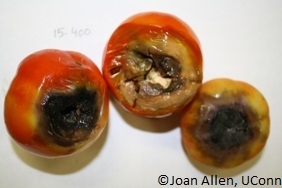
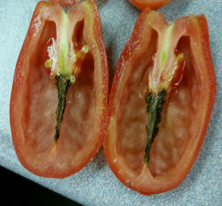
Misshapen fruit may result from poor pollination, often caused by cool, wet periods during flowering.
Sunscald of fruits occurs when green tomatoes are overexposed to direct sunlight. Excessive pruning and loss of diseased foliage are common causes. Excessive heat can cause an abiotic disorder called yellow shoulder (see below image).
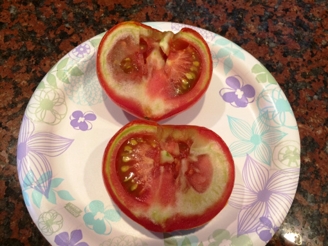
Growth cracks in fruits are common when long, dry periods are followed by rainy periods.
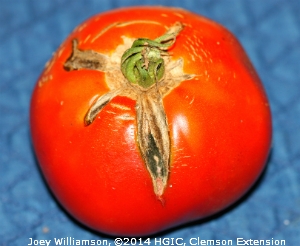
Deformed stems and leaves may signal injury from herbicides used on nearby lawns to control broadleaf weeds or when grass clippings from treated lawns are used as a mulch.
Find more articles on growing tomatoes on our Vegetable IPM page.
Despite good cultural practices, pests and diseases at times may appear. Chemical control should be used only after all other methods have failed.
For pesticide information or other questions please call toll free: 877-486-6271.
Revised by UConn Home and Garden Education Center 2020.
Issued in furtherance of Cooperative Extension work, Acts of May 8 and June 30, 1914, in cooperation with the U.S. Department of Agriculture, the Dean of the College, Cooperative Extension System, University of Connecticut, Storrs. The Connecticut Cooperative Extension System is an equal opportunity employer and program provider. To file a complaint of discrimination, write USDA, Director, Office of Civil Rights, Room 326-W, Whitten Building, Stop Code 9410, 1400 Independence Avenue, SW, Washington, DC 20250-9410 or call (202) 720-5964.
